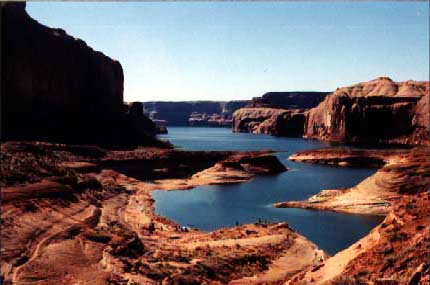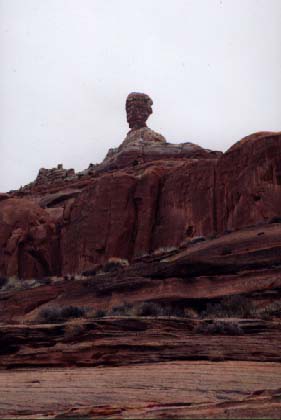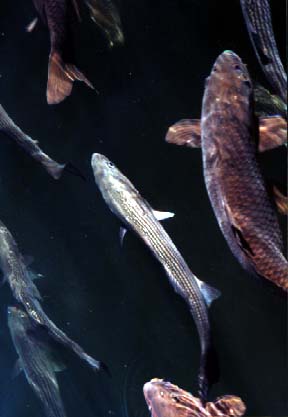|
|
Spring Fishing Lake Powell - 1999
By David Webb 
Striped bass command attention at Lake Powell in the spring, and often offer very good fishing. But early reports suggest this will not be a typical spring for stripers at the big lake. Fishing is expected to be good - really good at times - but also spotty. Action will not be as predictable as in years past.
The problem is a dwindling population of shad - the little fish that is normally a staple in the striper diet. The shad population is cyclic and fish numbers are low right now. Stripers are having to range extensively in search of food. They are often on the move and therefore more difficult to find. But when you find them they are hungry and will greedily attack lures, jigs and anchovies (the basic arsenal for striper fishermen).
Other sport fish at the lake are not as dependent upon shad. Smallmouth bass, largemouth bass, walleye, channel cats and bluegill should provide good to excellent fishing throughout the spring, summer and fall. Crappie fishing is always spotty, with some nice fish caught in the backs of canyons during the spring.
 Nature has a way of trying to
balance populations in any given environment, and that will be a factor this year at
Powell. Shad numbers are low and so stripers aren't getting enough to eat. Many stripers
are skinny - long snake-like bodies with big heads. Malnourished stripers are not becoming
sexually mature and so they will not show up at staging and spawning areas.
Nature has a way of trying to
balance populations in any given environment, and that will be a factor this year at
Powell. Shad numbers are low and so stripers aren't getting enough to eat. Many stripers
are skinny - long snake-like bodies with big heads. Malnourished stripers are not becoming
sexually mature and so they will not show up at staging and spawning areas.
Most years stripers migrate to the lower lake and huge numbers of the fish spawn on the dam. That is not expected this year. During the spawn stripers are attracted to moving water, like that found around the dam. Other areas with moving water also attract fish. In particular, fish usually congregate right on the face of the dam, around the power plant intake midway between Antelope and Navajo canyons, and at the inflows from the Colorado and San Juan rivers. Some fish will be found in these spots, but not in the usual numbers. However, staging areas may provide the best action for big fish, since mainly mature fish will gather there.
Staging usually begins in late March and continues into May. Stripers were unusually active through winter, probably because they were hungry. Most of the winter action was on the upper lake, as the stripers foraged for shad, crawfish or other edible morsels.
The most consistent spot has been the mud line at Hite (the area where darker water from the Colorado gives way to cleaner, clearer lake water). There is also a mud line on the San Juan arm, out from Piute Farms. The mud lines move up and down-lake, depending on inflows. During spring, when runoff is heavy, the mud lines may move down-lake a considerable distance.
Striper fishing is usually good for people trolling the mudlines. Trolling is also usually good along the cliffs directly across from the boat ramp at Hite.
Trolling is always more productive when you use a fish finder to
determine the location and depth of the fish, and a  downrigger to keep your lure in the "hot zone." Any shad-like lure will take
fish. An old standby is a gray broken-back Rapala.
downrigger to keep your lure in the "hot zone." Any shad-like lure will take
fish. An old standby is a gray broken-back Rapala.
Fish staging near the dam or the power plant intake can be caught jigging. Park over the fish and jig for them using a heavy lead-head hook (1/4-1/2 ounce) baited with 1/3 of an anchovy. The depth of the fish will determine the weight of the lead-head needed to get down to them quickly. Again, a fish finder will really help. But it's easy to find the productive spots because there will usually be a group of boats working those areas. Just pull in close (but not so close that you disrupt their sport) and take your chances.
Allowing a piece of anchovy to flutter down into the fish - using an unweighted hook - can be very enticing to the stripers. But you've got to be able to hold your position over the fish or you will drag the bait and it will never get deep enough. There is usually wind and wave action at Powell, and so it can be difficult to hold position. An electric trolling motor really helps.
Sometimes you will find schools of stripers resting, suspended in deep water, and they won't respond when you jig or troll through them. You can often stimulate them into feeding by dropping anchovy "chum" into the water over a school. Dice anchovies into small pieces and drop them into the water over the fish.
Many stripers will be caught this year by anglers targeting smallmouth or largemouth bass. Stripers are normally an open-water fish, but increasing numbers will be working the rockslides and other structure in search of crayfish, and anything else they can consume.
As spring gives way to summer, the most consistent way to catch stripers may be to fish for bass.
Bass
Largemouth become active in Powell about the middle of March. Smallmouth follow a couple weeks later. By late April bass fishing is very good at Powell.
Bass will be shallow during the spring, as they spawn along rocky shorelines in bays and toward the backs of canyons. The fish will move deeper as the heat of summer sets in.
Bass are most often caught casting plastic jigs or crank baits into rocky areas. Action is best during the first and last hours of daylight, but fish can often be caught throughout the day. During the spring you want to cast
into shallow water and work your lure along the bottom into deeper water. The lure should get right down into the rocks, so expect snags. Various shades of green and brown are usually effective.
Rockslides are very productive in the spring. Look for broken rocks extending down into the water. If there is a large rock surrounded by smaller, broken rocks, you can expect a nice bass at the base of the big rock.
Submerged brush and trees also offer good habitat for bass, particularly the largemouth. Such structure can be found in the backs of many canyons. Largemouth are often caught by anglers fishing nightcrawlers near submerged trees or off a ledge.
Other Species
Walleye are caught regularly at Powell, particularly during the month of May. They are spread throughout the lake and it is very hard to target them. Walleye are usually caught by people fishing for bass. There are also a few northern pike in the lake, but catching one is happenstance.
It is usually easy to catch bluegill at Powell. Get into the back of a canyon and tie up your boat near a large submerged rock. Fish a brightly colored jig or a worm near the base of the rock. Usually your bait will quickly attract fish. If the water is clear and not too deep you may be able to see fish following your bait. Periodically one will dash in and peck at your hook. It’s great fun for kids to fish this way - where they can see the action.
Catfish can be caught throughout the spring, summer and fall by fishing bait
in sandy coves toward the back of canyons. Worms and table scraps can be effective. A chunk of hot dog works well. "Little Smokey" sausages are very good for catfish, and for bluegill.
Fishing is usually good at Powell during the summer season - when most people choose to visit this popular water playground. But the best action is in the spring and fall - before the crowds come and then after they go home.